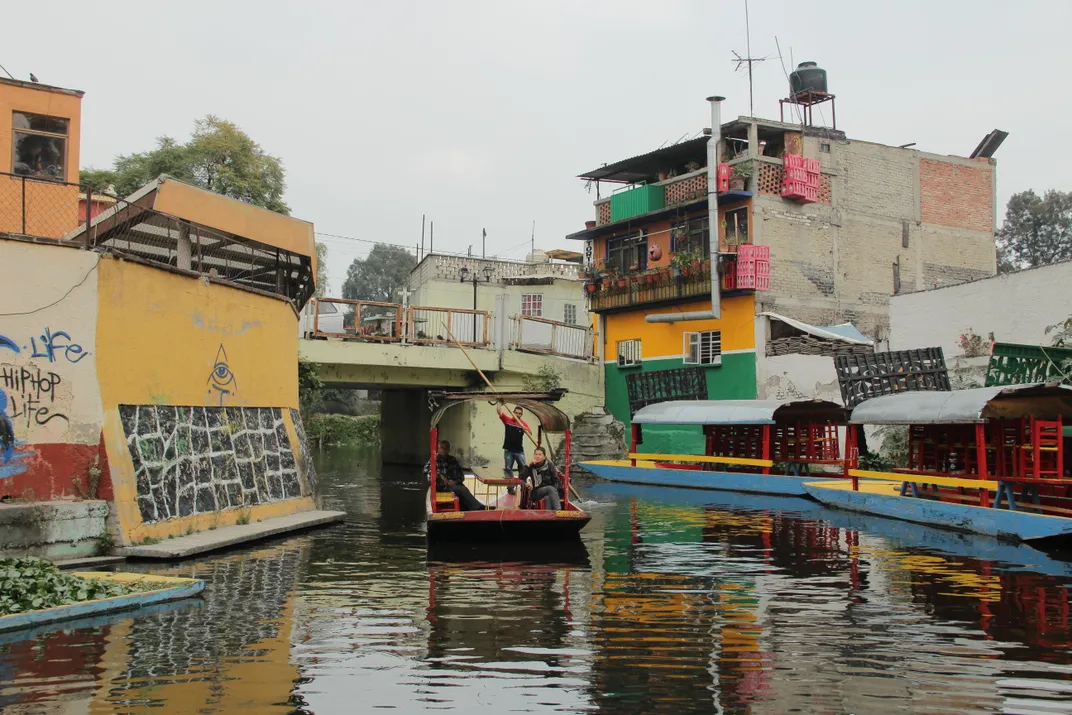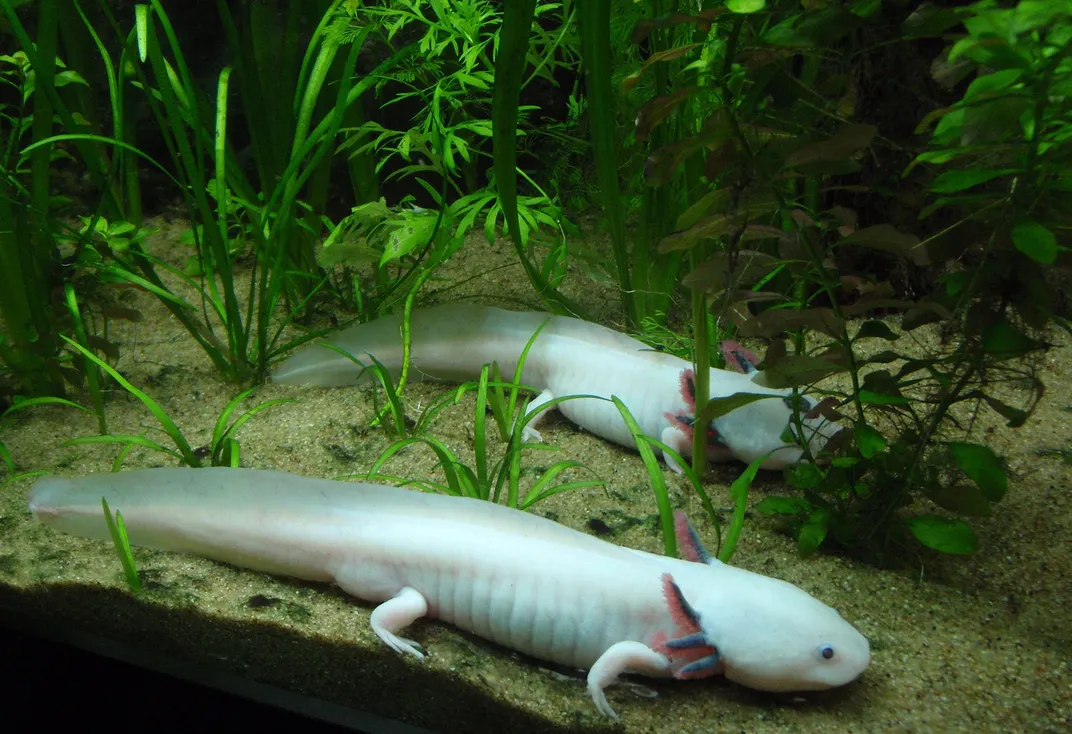Despite being a common pet and beloved cultural icon, the grinning amphibian is nearly extinct in the wild
/https://tf-cmsv2-smithsonianmag-media.s3.amazonaws.com/filer/0e/7a/0e7a1cb2-9585-48d6-aae3-6785498943f2/b8c6tt.jpg)
Amphibians are not often considered charismatic. The axolotl is different.
With its ear-to-ear grin, pink feathery headdress of gills and frantic underwater dance, this amphibian has captivated generations of admirers. Once revered by Aztecs, today the axolotl appears in many forms. It is a symbol for Mexican national identity in anthropologist Roger Bartra’s book La Jaula de la Melancolia (The Cage of Melancholy); Mexican muralist Diego Rivera includes axolotl swimming near a male figure’s genitals—the center of creation—in his mural “Water, Origin of Life.”
You may have heard of the axolotl because its image is so ubiquitous—and so, it seems, is it. Millions of the creatures thrive around the world. The axolotl is a popular pet, particularly in Japan, where they are bred so widely that they are also served deep-fried at some restaurants. They are also distributed so commonly to labs for research that they are basically the white mice of amphibians, thanks to their unique genetic profile and their potential to unlock the secrets of evolution and regeneration.
But few realize that, in nature, the axolotl is in peril. It is native only to Lake Xochimilco, a UNESCO World Heritage site outside Mexico City, where it has long played a role in Mexican tradition. And there, it is on the brink of extinction.
In 2006, the species was declared critically endangered due to habitat degradation and the pervasiveness of invasive fish in the lake, introduced decades ago in a well-intentioned attempt to create fisheries and alleviate food insecurity. In 2009, experts estimated that the axolotl population had fallen 90 percent in the past four years, a decline further exacerbated by urbanization. In 2015, scientists briefly believed that the critter might have gone fully extinct in the wild—only to find one a few weeks later.
When Luis Zambrano started working with the axolotl in 2002, he knew only a little about the curious critter’s cultural significance to Mexico and their popularity throughout the world. Zambrano, a biologist at the National Autonomous University of Mexico (UNAM), had previously focused on food webs of fish; he started working with axolotls when fellow researchers in his lab asked if he would help them find axolotl in his by-catch. He was eventually instrumental in designating the axolotl as a threatened species and is now the leading expert on their conservation.

At first, Zambrano dreaded working the amphibians. Axolotls are frustratingly difficult to catch (besides that, there are very few left) and the local people initially didn’t seem keen to work with him, he says. But as he learned of the animals’ rich cultural and biological significance, he quickly grew entranced by the amphibians. He even found a connection to his prior research: as aquatic predators, axolotls are highly important in food webs. Zambrano started to explore how they interact with different species, how they predate, and how they are preyed upon.
“It was like starting with a bad date and falling in love,” he laughs now.
According to Zambrano, axolotls face a variety of threats in their natural habitat. They are only found in Lake Xochimilco, but Lake Xochimilco is suffering. The lake system is highly eutrophic, meaning it is so rich in nutrients from agricultural runoff that the booming plant life kills the endemic species by depriving them of oxygen. Invasive Asiatic carp and tilapia, introduced by the government to increase food security in underserved communities, have now supplanted the axolotl as the top predators, and are known for picking off the scrumptious juveniles.
Pollution from Mexico City is also an issue: strong storms can cause the city’s sewer system to overflow and release human waste into Lake Xochimilco. With their permeable amphibian skin, axolotls are particularly vulnerable to the ammonia, heavy metals, and other toxins carried by human excrement.
At the same time, Mexico City is rapidly expanding, and outlying areas like Xochilmilco become hotbeds for legal and illegal development. Developers view areas like Xochimilco opportunistically and have been grabbing up permits for large-scale developments in critical areas. As people migrate to Mexico City for work, those who cannot afford to live in the central areas look for places to live on the outskirts. Zambrano has observed that not only is the axolotl stressed by noise, but the rapid urbanization also presents untold threats to its only habitat.
To the casual onlooker, it may seem like Lake Xochimilco is a lost cause. Moreover, you might ask, why invest in a doomed lake if the axolotl is already thriving in labs and pet stores throughout the world?

…..
The problem is, having captive populations of axolotls is not enough, says Randal Voss, a biologist at the University of Kentucky. Voss, who maintains a collection of axolotls for distribution to labs around the world as Resource Director of the Ambystoma Genetic Stock Center, knows the problem intimately. When he looks at his pedigree records, he knows the stock is inbred and thus has less genetic diversity due to the mating between related animals.
In one sense, a homogeneous stock can be good for science, as it is much more likely to facilitate reproducible studies. “On the other hand, it can compromise the health of a captive population,” Voss explains.
Captive populations are more vulnerable to catastrophe. Disease, or even an accidental fire, could wipe out an entire lab population almost instantaneously. Between the inbreeding and efforts to cross the axolotl with the tiger salamander to introduce some genetic diversity, the collection is also very different than the wild populations; not only are their genomes different, but they are highly domesticated and adapted to humans.
Researchers like Voss are working on sequencing the wild axolotl genome, but the sheer size of the genome and the lack of access to wild populations means they have not yet completed it. If the animals went extinct before they could complete the sequencing, they would lose the groundwork for many studies that use the axolotl’s unique molecular toolbox.
That’s key, because axolotls are one of the most important animals we have for studying regeneration. When an axolotl loses its limb or crushes its spine, it is able to regenerate the lost or damaged body parts with stunning perfection. Scientists have seen these creatures regenerate an entire limb in as little as 40 days, with immune cells called macrophages building up tissue until a new limb is formed. As scientists are now learning, certain microRNA groups give axolotls and other salamanders this superpower.
They aren’t unique in this trait. “Regeneration is not special or specific to axolotl,” Voss explains, “It’s just that the axolotl is the best model amongst all the salamanders for doing this research.” Moreover, axolotls have enormous embryos, the largest amongst amphibians, which are useful for stem cell research.
Yet perhaps the axolotl’s most crucial trait to scientists goes back to that adorable baby face.
…..
Axolotls are neotenic, which means that unlike other amphibians, they reach sexual maturity without undergoing metamorphosis. Frogs, for example, are aged tadpoles; axolotls maintain their youthful, larval visage throughout all stages of their lives. Axolotls evolutionarily shed the thyroid hormone that triggers metamorphosis to adapt to habitats with low levels of iodine and other resources necessary for maturation.
And because axolotls don’t go through metamorphosis, they don’t depend on the seasons and other environmental factors for breeding. That means scientists can breed them throughout the course of the year. Axolotls may also offer insight to the genetic controls that regulate the switch in life for processes like puberty.
With the race against the clock growing ever pressing, the axolotl conservation efforts ramped up in the early 2000s with a proposed captive breeding and species reintroduction project. Richard Griffiths, professor of biological conservation at the University of Kent and leader of the axolotl conservation efforts for the Darwin Initiative, the UK Government’s funding program to assist with biological diversity projects in the developing world, recognized early on that reintroduction was a long shot given the threats to the species in Lake Xochimilco.
“There really wouldn’t be any point to doing captive breeding and reintroduction,” Griffiths explains. “One of the rules of captive breeding is you have to sort the threats out first.”
Thus, the team developed an action plan in 2004 to raise the profile of the axolotl in the local community through education programs, workshops, and public meetings. They focused on integrating the axolotl into the tourism in the community. One of Griffiths’s favorite projects was the training programs for romeros, or boatmen, to become guides for tours about the axolotl for tourists visiting the lake.
“It’s the best captive audience,” Griffiths jokes. “You have eight people in a boat, and they can’t get off!”
Local businesses like La Casita del Axolotl breed axolotls for sale and conduct tours with their guests and clients. “We work with the tourism that we see at the traditional piers,” explains Karen Perez, one of the managers of La Casita del Axolotl. “We give our guests an explanation about axolotls and what they can do for them.”
…..
The local community was always essential for the axolotl conservation efforts. The difficult method of collecting axolotls—searching for subtle bubbles and casting the net just right—that is needed for censuses is hard to teach, but it is a skill that is passed down through generations of local fishermen.
It wasn’t always smooth sailing in Xochimilco. “When I started to work in Xochimilco, it was not easy,” Zambrano says. Locals distrust scientists, who have historically exploited the community for data in the past without coming back or paying them sufficiently. Zambrano approached the relationship differently. He knew the community had all the knowledge he needed, so he offered his data collecting skills and credibility as a way for them to have their voices heard—and to help their livelihoods.
These efforts have scaled up in recent years as Zambrano involves local farmers in the process. Local farmers are encouraged to farm with traditional chinampas, or “floating gardens” constructed with aquatic vegetation and mud from the lake, to create sanctuaries for the axolotl. The productive and sustainable agricultural system does not use chemical pesticides—they have even experimented with grinding up invasive tilapia for fertilizer—and creates a semi-permeable barrier to provide refuge for the axolotl with clean, filtered water.
“We are not discovering anything new that wasn’t discovered 2,000 years ago,” Zambrano explains.
It may not be enough. “Despite all this work, there is no doubt that the axolotl is in decline within the larger system,” says Griffiths, pointing out that the threats to the lake system are simply too great. Zambrano is hopeful. He has seen a steady increase in interest in the axolotl, which he hopes to leverage into local government action. The first step, he says, is to save Xochimilco.
In Julio Cortázar’s 1952 short story “Axolotl,” the narrator writes that “the axolotls were like witnesses of something, and at times like horrible judges,” before turning into one himself. If history doesn’t change, experts warn, real life axolotls may witness is their own demise.
“I think that we are in a threshold in this moment,” says Zambrano. “But if we follow the path that we have followed for the last 50 years where the government is trying to rescue Xochimilco through more human development, then [the axolotl] will definitely be extinct in the next 10 years.”





